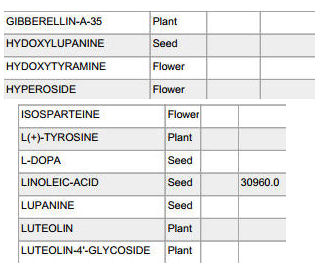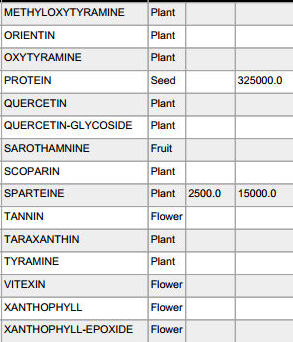|
|
Practical ecological knowledge for the temperate reader. |
Family: Fabaceae/Leguminosae (Pea)
Other Names:
common broom; Scot's broom; Scottish broom [E-flora]
"Scotch broom herb has been taken by mouth traditionally for a variety of conditions related to the heart or blood circulation. These include abnormal heart rhythms (arrhythmias), fast heart rate (tachycardia), swelling in the legs (peripheral edema), water in the lungs (pulmonary edema, congestive heart failure), and low blood pressure (hypotension)." [NNF]
Synonyms
General Woody shrub [WildPNW] "...growing to 2.4 m (7ft) by 1 m (3ft 3in) at a fast rate." [PFAF] Unarmed. [PCBC2004]
Lifecycle Perennial.[WildPNW]
Flowers "The flowers are hermaphrodite... and are pollinated by Bees.The plant is not self-fertile." [PFAF] Bright yellow. [WildPNW]
Fruits "legumes 2.5-4 em. long, glabrous except for long hairs on the
margins. "[HNW] Black..."the two
halves tend to warp in different directions,
eventually snapping apart..." [PCBC2004]
Leaves "Alternate, deciduous, small,..." [PCBC2004] "Leaves are mostly 3-parted with entire leaflets."[WildPNW] "...sometimes tinged
with purple, typical 'pea'-flower,..." [PCBC2004]
Stem "Stems not round but angled with
5 edges..."[WildPNW]
Habitat "Mesic to dry fields, rocky slopes, roadsides and powerline rights-of-way..."[IFBC] [E-flora]
Range "locally common in SW BC..."[IFBC] [E-flora]
Status Exotic [E-flora] Invasive. [WildPNW]
Ecological Indicator
"A shade-intolerant, submontane to montane, European deciduous shrub introduced to Pacific and Atlantic North America. Occurs in maritime to submaritime summer-dry cool meso thermal climates on very dry to moderately dry, nitrogen-medium soils. Its occurrence decreases with increasing latitude, elevation, and continentality. Inhabits exposed mineral soil in earlyseral, non-forested communities on strongly drained, water-shedding sites. Symbiotic with nitrogen-fixing organisms. Characteristic of disturbed sites." [IPBC][E-flora]
Similar Species "There are several weedy species of the genus Cytisis that are found on the Pacific Coast and Cascade Mountains." [WildPNW] "Var. andreanus Dipp. A form having dark crimson wings is an occasional
escape from cultivation. [HNW]
Gorse - Ulex europaeus is another weedy introduced species. It has many thorns and yellow pea-like flowers "...smelling of coconut (or bruised peaches)". Gorse is much less common than Scotch Broom and ranges mostly on South East Vancouver Island.[PCBC2004]
Notes It can tolerate atmospheric pollution and maritime exposure. [PFAF] "A high percentage of broom seeds (greater than 65%) have been found to be impervious in some studies, which can delay germination from months to years, contributing to the seed bank (Bossard 1993)." [E-flora]
Lore: Broom is used in purification and protection spells, and is hung in the home to keep evil out. Also, an infusion of broom sprinkled through the house exorcises poltergeists. Although the infusion was once used as a drink to increase psychic powers, this can be dangerous because the plant is slightly poisonous; carry instead for this purpose.[EMH Cunningham]
Diuretic: Scotch broom preparations, particularly those made from the flower, have been used traditionally as diuretics (to increase urination). Diuretic effects have been attributed by some to the constituent scoparin or scoparoside. [NNF]
|
Alkaloids
Simple amines
Flavonoids
|
Flavones
Isoflavones
Pigments
|



Contains "amino acids, volatile oil (containing 4-mercapto-4- methylpentane-2-one); coumarins, cafeic acid derivatives; tannin; wax; fat; and sugars".[Leung ECNI]
"Essential oil of the fresh flowers contains alcohols, coumarins, eugenol, benzoicacid, guaiacol, fatty acids,and others." [Leung ECNI]
Seed Oil FAs Composition, %: 12:0 – 0.1; 12:1 – 0.2; 14:0 – 0.2; 14:1 – 0.3; 16:0 – 16.7; 16:1 – 0.5; 18:0 – 4.4; 18:1 – 20.0; 18:2 – 51.6; 18:3 – 4.3; 20:0 – 0.6; 20:3 – 0.7; 22:0 – 0.4 [LLCEOPS]
"Since only sparteine can be easily isolated from broom (Cytisus scoparius), it is the only lupin alkaloid that is commercially available and exploited in medicine as an antiarrhythmic drug. However, about 10% of all patients are unable to metabolise sparteine and suffer from sparteine intoxication. Because of these side effects and the availability of more reliable synthetic heart drugs, the use of sparteine in modern medicine is declining and restricted. The utilisation of sparteine as a uterus-contracting drug has been abandoned for the same reasons." [Nagata MAPS 12]
"Succeeds in most soils, preferring a fairly good but not rich soil[11]. Prefers a poor well-drained soil[14]. Succeeds in slightly acid, neutral and limy soils but dislikes shallow soils over chalk[200]. Plants are strongly calcifuge according to other reports and intolerant of a pH much above 6.5[17, 186]. Prefers a sunny position but tolerates some shade[11, 14, 17]. Plants succeed in exposed conditions, and are very tolerant of maritime exposure[4, K]. Plants have a deep root system, they are very drought tolerant once established and grow well on dry banks[4, 11]. Tolerates a smoky atmosphere, growing well in polluted areas[186]. Plants are hardy to about -20°c[184]. A number of named forms have been developed for their ornamental value[182]. New leaves are formed in April but these soon drop off the plant, photosynthesis being carried out by means of the green stems[186]. Very tolerant of cutting, it regenerates quickly from the base[186]. Plants are usually killed by fire but the seeds quickly germinate after the fire and rapidly become established[186]. A good bee plant and food plant for many caterpillars[24, 30, 46], it provides the food for the larvae of the green hairstreak butterfly[186]. Ants are attracted to the seeds, feeding on the juicy attachment that holds them to the pods and thus distributing the seed[186]. Dislikes root disturbance, especially when more than 20cm tall[11]. It is best to plant out into their permanent positions as early as possible. This species has a symbiotic relationship with certain soil bacteria, these bacteria form nodules on the roots and fix atmospheric nitrogen. Some of this nitrogen is utilized by the growing plant but some can also be used by other plants growing nearby[200]." [PFAF]
Pests
"...Aphis cytisorum, which infests broom plants (Cytisus
scoparius), accumulates up to 0.5 mg alkaloid per gram fresh
weight. The alkaloids are similar in composition to those of
the host plant, 17-oxosparteine (25), sparteine (17), 12,13-
dehydrosparteine, and iupanine (21) (Wink et al., 1982). [Seiger PSM]
Because of its strong seed coat dormancy, its seeds remain viable in the forest floor seed bank for up to thirty years.[82][GPG]
"Seed - best sown as soon as it is ripe in the autumn in a cold frame[80]. Pre-soak stored seed for 24 hours in warm water then cold stratify for 1 month and sow in a cold frame[80]. The seed usually germinates in 4 weeks at 20°c[98, 113]. Seedlings should be potted up as soon as possible since plants quickly become intolerant of root disturbance[186]. Plant them out into their permanent positions in late summer if they have made sufficient growth, otherwise in late spring of the following year[K]. The seed has a long viability[186]. Seed can also be sown in situ as soon as it is ripe in the late summer and autumn[4]. Cuttings of half-ripe wood, 4 - 7 cm with a heel, August in a frame[11]. Produces roots in the spring[11]. Pot up as soon as possible[11]. Cuttings of mature wood, October/November in a frame. Layering." [PFAF]
CYTISUS
Shrub, [small tree], unarmed.
Stem: often ribbed, green, to 5 m.
Leaf: 1-compound (generally ternate), generally alternate, petioled; stipules free or 0.
Inflorescence: generally terminal racemes, or axillary, peduncled clusters of 1–4(7) flowers.
Flower: calyx bell-shaped to cylindric, 2-lipped, upper lip ± 2-lobed, lower generally 3-lobed; petals 5, generally yellow or white, generally not hairy, keel oblong-sickle-shaped to ± 1/2 circular (curve abaxial), claw ± 1/4 keel; stamens 10, filaments fused; style generally abruptly curved at ± middle or gently curved ± throughout.
Fruit: dehiscent, generally oblong, papery to ± leathery; pedicel short.
Seed: few to many, generally arilled.
65 species: Europe, western Asia, northern Africa, Canary Islands; some cultivated. (Greek: name for several woody Fabaceae) Chamaecytisus (30 species) often segregated but recent work (Cristofolini 1991 Webbia 45:187–219; Cubas et al. 2002 Plant Syst Evol 233:223–244) supports treatment as 1 monophyletic group.
[Jepson]
Local Species
| Ethnobotanical Uses and Properties of Various Cytisus Sp. [DukePhyt] | |
| Cytisus laburnum | |
| Asthma [Steinmetz]; Cholagogue [Steinmetz]; Emetic [Steinmetz]; Pertussis [Steinmetz]; Poison [Steinmetz]; Purgative [Steinmetz]; Tumor [Hartwell] | |
| Cytisus purgans | |
| Purgative [FontQuer] | |
| Cytisus scoparius | |
| Abortifacient* [Lewis]; Arrhythmia* [Woi.2]; Bruise [Bliss]; Cardiotonic [Takeda, Woi.2]; Cold [Bliss]; Cough [Bliss]; Diuretic [Steinmetz, Takeda, Woi.2]; Dropsy [Woi.2]; Emetic [Woi.2]; Palpitation* [Woi.2]; Poison* [Lewis, Steinmetz]; Purgative [Steinmetz, Woi.2]; Sedative [Steinmetz]; Smallpox [Bliss]; Tachycardia* [Woi.2]; Tea [Bliss]; Tumor [Hartwell]; Vasoconstrictor [Steinmetz] | |
Soil Conditioner
"Giesta (Cytisus) is the dominant or only
woody plant on about one-quarter of the land area of the high granite mesas of interior
Beira Alta, Portugal, where for at least the past 800 years the main cereal crop has been rye.
During this time, a substantial fraction of this crop has been sold and taken to cities to feed
the urban population, carrying with it nitrogen in the proteins of the grain. These farms have
remained sustainable for nitrogen in the face of this outflow because farmers have allowed
and even encouraged giesta, which is a nitrogen fixer, to occupy a substantial fraction of the
land area, from which it is harvested and buried in the cultivated soil to restore its fertility." [Estabrook]
"Cytisus albidus (= Chamaecytisus mollis) is regarded as one of, if not 'the' best browse species in Morocco (Shoenenberger, pers. comm. 1980) where it is an endemic species in the atlantic, coastal, semi-arid and arid sandy plains matorrals. Direct sowing has been used in the improvement of forest rangelands at altitudes up to 1000 m of elevation in the western High Atlas (Shoenenberger, ibid.)" [Wickens PAL]
"Cytisus villosus (= C. trij1orus) is a high rainfall browse species in the Quercus faginea and Q. suber forests." [Wickens PAL]
"...Yaqui medicine men from northern Mexico employ Genista canariensis, the genista of florists, for the purpose of inducing hallucinations (17), a property that has been experimentally substantiated. The genus Genista and the closely related Cytisus, in which Genista canariensis is sometimes included, are extremely rich in alkaloids. Cytisine, an alkaloid that formed the basis for the former hallucinogenic use amongst some North American Plains Indians of seeds of the leguminous ''Sophora secundiflora' (53), has been isolated from leaves and beans of Genista canariensis." [Ethsearchpsych]